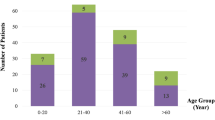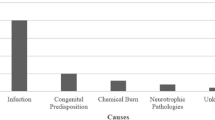Abstract
Objective
Despite advances in ocular and orbital imaging, instrumentation, materials, and surgical procedures, the management of open globe injuries continues to pose difficult management dilemmas. In this retrospective study, we identify clinical characteristics and outcome of a series of open globe injuries presenting to a major UK centre.
Method
Operating department records were reviewed to identify all patients who had undergone repair of an open globe injury from 1 January 1998 to 1 January 2003 at the Manchester Royal Eye Hospital. Case notes were examined to determine demographic data, mechanisms of injury, influence of alcohol/drugs, and location of injury. The Snellen visual acuity on presentation and initial clinical signs were recorded.
Results
In total, 115 cases of open globe injury were identified of which 107 cases notes were available for review. Injury to the eye with a sharp object accounted for 71/107 (66%) cases and blunt mechanisms for 30/107 (28%) cases. In six (6%) cases the cause of injury was unknown. The rate of secondary enucleation in our series of 107 open globe injuries was 13/107 (12%). Significant risk factors on presentation associated with eventual enucleation included relative afferent pupillary defect (P<0.001), absence of a red reflex (P<0.001), presence of a lid laceration (P<0.02), a blunt mechanism of injury (P<0.02), and an initial VA worse than 6/60 (P=0.03).
Conclusion
From this retrospective study, we have identified several factors that may aid the clinician in deciding on the prognostic value of primary repair. Blunt injuries associated with adnexal trauma, with poor initial visual acuity, the presence of an RAPD or retinal detachment, and the absence of a red reflex are associated with a significantly higher rate of subsequent enucleation.
Similar content being viewed by others
Log in or create a free account to read this content
Gain free access to this article, as well as selected content from this journal and more on nature.com
or
References
Dannenberg AL, Parver LM, Fowler CJ . Penetrating eye injuries related to assault. The National Eye Trauma System Register. Arch Ophthalmol 1992; 110: 849–852.
Dannenberg AL, Parver LM, Brechner RJ, Khoo L . Penetrating eye injuries in the workplace. The National Eye Trauma System Registry. Arch Ophthalmol 1992; 110: 843–848.
Tielsch JM, Parver L, Shankar B . Time trends in the incidence of hospitalised trauma. Arch Ophthalmol 1989; 107: 519–523.
Gilbert CM, Soong HK, Hirst LW . A two-year prospective study of penetrating ocular trauma at the Wilmer Ophthalmological Institute. Ann Ophthalmol 1987; 19: 104–106.
Liggett PE, Pince KJ, Barlow W, Ragen M, Ryan SJ . Ocular trauma in an urban population. Review of 1132 cases. Ophthalmology 1990; 97: 581–584.
Desai P, MacEwen CJ, Baines P, Minassian DC . Incidence of cases of ocular trauma admitted to hospital and incidence of blinding outcome. Br J Ophthalmol 1996; 80: 592–596.
Fong LP . Eye injuries in Victoria, Australia. Med J Aust 1995; 162: 64–68.
deBustros S, Michels RG, Glaser BM . Evolving concepts in the management of posterior segment penetrating ocular injuries. Retina (Suppl) 1990; 10: S72–S75.
Kuhn F, Morris F, Witherspoon CD, Mester V . The Birmingham Eye Trauma Terminology system (BETT). J Fr Ophthalmol 2004; 27: 206–210.
Groessl S, Nanda SK, Mieler WF . Assault-related penetrating ocular injury. Am J Ophthalmol 1993; 116: 26–33.
Smith D, Wrenn K, Stack LB . The epidemiology and diagnosis of penetrating eye injuries. Acad Emerg Med 2002; 9: 209–213.
Esmaeli B, Elner SG, Schork MA, Elner VM . Visual outcome and ocular survival after penetrating trauma. A clinicopathologic study. Ophthalmology 1995; 102: 393–400.
Wong TY, Tielsch JM . A population based study on the incidence of severe ocular trauma in Singapore. Am J Ophthalmol 1999; 128: 345–351.
Klopfer J, Tielsch JM, Vitale S, See LC, Canner JK . Ocular trauma in the United States. Eye injuries resulting in hospitalization, 1984 through 1987. Arch Ophthalmol 1992; 110: 838–842.
Pieramici DJ, MacCumber MW, Humayun MU, Marsh MJ, de Juan Jr E . Open globe injuries. Update on types of injuries and visual results. Ophthalmology 1996; 103: 1798–1803.
Williams DF, Mieler WF, Abrams GW, Lewis H . Results and prognostic factors in penetrating ocular injuries with retained intraocular foreign bodies. Ophthalmology 1988; 95: 911–916.
Dunn ES, Jaeger EA, Jeffers JB, Freitag SK . The epidemiology of ruptured globes. Ann Ophthalmol 1992; 24: 405–410.
Hatton MP, Thakkar MM, Ray S . Orbital and adnexal trauma associated with open globe injuries. Ophthalmol Plast Reconstr Surg 2002; 18: 458–461.
Author information
Authors and Affiliations
Corresponding author
Additional information
Interests, financial and other: None
Rights and permissions
About this article
Cite this article
Rahman, I., Maino, A., Devadason, D. et al. Open globe injuries: factors predictive of poor outcome. Eye 20, 1336–1341 (2006). https://doi.org/10.1038/sj.eye.6702099
Received:
Accepted:
Published:
Issue date:
DOI: https://doi.org/10.1038/sj.eye.6702099
Keywords
This article is cited by
-
International Globe and Adnexal Trauma Epidemiology Study (IGATES): Visual outcomes in open globe injuries in rural West India
Eye (2023)
-
Epidemiology and prognosis factors in open globe injuries in the Federal District of Brazil
BMC Ophthalmology (2022)
-
Non-traumatic open globe injuries: presenting characteristics and visual outcomes
Eye (2022)
-
Epidemiological Characteristics and Outcome of Open Globe Injuries in Tabuk City, Kingdom of Saudi Arabia: Retrospective Cohort Study
Ophthalmology and Therapy (2022)
-
Visual outcomes of open globe injury patients with traumatic cataracts
International Ophthalmology (2022)



